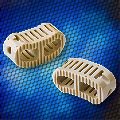There are certain polymers out there that can be classified as millable or machinable. When millable plastics are needed for the aggressive environments encountered by oil and gas equipment, the challenge to find a suitable polymer becomes even harder.
Top 3 Polymer Materials for Medical Implants
Designing a component for use in the human body is extremely challenging, and there are many regulations involved. In this blog post, we’ll talk about the top three polymers that are commonly used in medical implants:
- PEEK
- UHMW PE
- PSU
Understanding the Glass Transition Temperature of Polymers
As you know, polymers behave very differently from metals. One aspect of that behavior involves the glass transition temperature. In this blog post, we are going to focus on the glass transition temperature of thermoplastics.
4 Key Benefits of PTFE Energized Seals for the Aerospace Industry
PTFE energized seals have found a multitude of applications in the aerospace industry.
Thermal Analysis Techniques for Polymers, Part 2: DSC, TGA, EGA
This blog post represents the second installment in a series of posts on thermal analysis techniques for polymers. In part 1 we discussed differential thermal analysis, thermomechanical analysis, and dynamic mechanical analysis.
Thermal Analysis Techniques for Polymers, Part 1: DTA, TMA, and DMA
In this blog post, we are going to start a discussion about the most common thermal analysis techniques used to investigate the properties of polymers. In part 1 of this series, our focus will be on:
- differential thermal analysis
- thermomechanical analysis; and
- dynamic mechanical analysis
This discussion will include how these tests are performed and what kind of properties can be determined from the resulting data.
Importance of Spring Energizer Design in Cryogenic Sealing
Cryogenic seals are required in a variety of industries, including LNG fueling systems, specialty gas manufacturing, cryo coolers, radio astronomy, scientific instrumentation, pharmaceutical research, and many more. One of the most reliable sealing solutions for cryogenic applications are polymer spring-energized seals. In this blog post, we are going to review spring-energized seals and then discuss what the recommended spring configuration is for cryogenic applications.
The 3 Most Popular Spring Energized Seals Materials for Cryogenic Sealing Applications
Cryogenic sealing applications are challenging, to say the least. One popular solution is the use of spring-energized seals, and in this blog post we are going to talk about the 3 post popular materials used for spring-energized seals for cryogenic applications: PTFE, modified PTFE, and UHMW PE.
Types of Polymer Seals and Materials for the Medical Industry
Seals are a vital part of the medical industry, and you will typically see high performance polymers seals used because of the critical need for reliability.
Key Advantages of PTFE for Bellows
Bellows can perform a variety of tasks in a mechanical system, including vibration dampening, absorption of displacement in a piping system, compensating for misplacement and misalignment, and the protection of brittle components (glass, graphite, glass-lined steel, etc.).
- « Previous Page
- 1
- …
- 17
- 18
- 19
- 20
- 21
- …
- 33
- Next Page »




